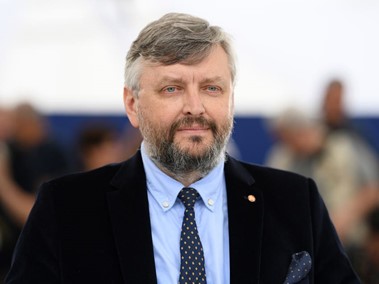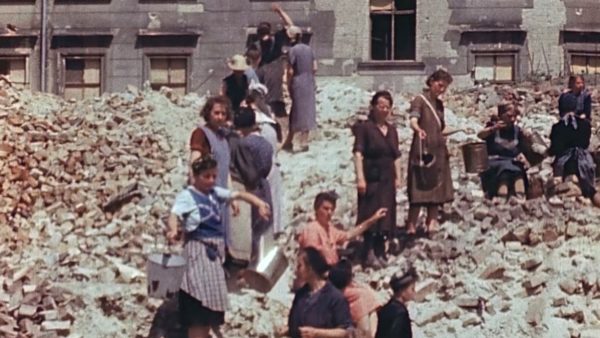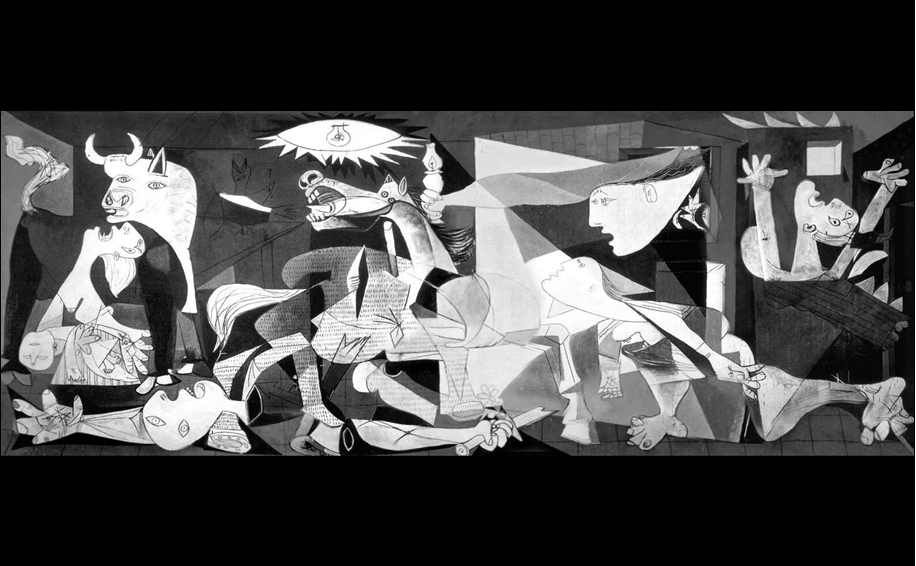“In any case, it is difficult to disprove the thesis that we have not yet succeeded in bringing the horrors of the air war to public attention through historical or literary accounts.”
— W. G. Sebald, “On the Natural History of Destruction” (1999), chapter 3
Sergei Loznitsa, who is widely recognized as the leading Ukrainian filmmaker of his generation, is, at least in the United States, not a household name. Indeed, I expect that many American film enthusiasts and cinephiles could not name more than one or two of his films — most obviously, perhaps, “Austerlitz” (2016), his feature documentary about concentration-camp tourism.
Attention was drawn to Loznitsa in 2022 when the Ukrainian Film Academy expelled the filmmaker because of what was seen as his disloyalty to Ukraine:
“Since the beginning of Russia’s full-scale invasion of Ukraine, we have tirelessly called on the global film community to boycott Russian cinema. But Sergei Loznitsa publicly opposes this, thus denying the Russians’ collective responsibility for the war their country unleashed in Ukraine….”
The Academy added that Loznitsa had “repeatedly stressed that he considers himself a cosmopolitan, ‘a man of the world.’ However, now, when Ukraine is struggling to defend its independence, the key concept in the rhetoric of every Ukrainian should be his national identity.”
Loznitsa’s public response was unequivocal: “By speaking out against cosmopolitanism, the Ukrainian Academy members employ this very discourse invented by Stalin, based on hatred, denial of freedom of speech, advocating collective guilt and forbidding any manifestations of individualism and individual choice.… I am against the boycott of my colleagues, Russian filmmakers, who are speaking out against the crimes of Putin’s regime.” For Loznitsa the Ukrainian Film Academy’s focus on national identity was akin to Nazism and “a gift to Kremlin propagandists.”
Over the decades Loznitsa has worked in several different cinematic modes. His earliest films often reveal similarities to the work of American independent filmmakers like Peter Hutton and James Benning. His feature melodramas — “My Joy” (2010) and “A Gentle Creature” (2017), in particular — are a new kind of political horror film. “Maidan” (2014) is a gripping direct-cinema documentary of the popular revolution that, for a moment, freed Ukraine from Russian dominance. And he is perhaps most accomplished at transforming archival film into powerful commentaries on the past and its relevance to modern life.
The COVID-19 pandemic forestalled Losnitsa’s ability to shoot melodramas and record cinema-verité documentaries, but it freed him to immerse himself in archival projects. Over a period of two years, he produced four feature films, including “Babi Yar. Context” (2021) and “The Kiev Trial” (2022) both of which focus on the Ukrainian Holocaust during the second World War.

Sergei Loznitsa, film director
In “Babi Yar,” the “context” for the extermination of Ukrainian Jewry is two invasions: Nazi Germany’s invasion, wresting control of Ukraine from the USSR, and the subsequent invasion by the USSR, resuming its control. The focus of “The Kiev Trial” is the trial by the Ukrainians of several captured Nazis. Loznitsa lays bare the German atrocities but does not suppress Ukraine’s complicity — indeed, one cannot help but wonder if his honesty was a problem for the Ukrainian Film Academy.
The third feature, “Mr. Landsbergis” (2021) — Loznitsa’s longest film to date (248 minutes) — is a blend of archival film and television footage combined with what is essentially a narration by Vytautas Landsbergis (actually, excerpts from Loznitsa’s extended interview with him), whose leadership of the Sajūdis Lithuanian pro-independence movement, from 1988 to 1991, led Lithuania’s transition from Russian control to a free, democratic republic, with Landsbergis as its head of state. Landsbergis’s quiet political acumen seems an antidote to Hitler’s and Stalin’s (even Gorbachov’s) negotiation by brutal force.
The fourth feature, “The Natural History of Destruction” (2022), which is based on the book by W.G. Sebald, at first seems rather different in focus from the other 2021-22 films, except in its confrontation of easy assumptions about history and ideology.
My own first experience with “Natural History” seems instructive. My takeaway was that the film was about the mutual brutalities of the second World War, as they played out between the U.K. and Nazi Germany. I assumed I was seeing the devastation that Germany visited on the U.K. and the response of the Allies — though my nagging feeling was that the film didn’t reveal this balance effectively: the Nazis didn’t seem to cause as much devastation as the Allies.
As I watched the film more carefully, I realized that the focus of “The Natural History of Destruction” is not the mutuality of destruction between the Allies and the Axis, but Loznitsa’s attempt to see the war from the point of view of the Germans — or to be more precise, to consider the full implications of the Allied response to the German war machine.
“The Natural History of Destruction” begins with opening credits in an obviously German typeface, leading into an extended prelude focusing on German life before the war. First, there is idyllic, pastoral imagery: shepherds and sheep, a boy herding geese, old men hanging out, traditional German homes and churches, fishing boats in a small harbor, a hand-cranked drawbridge, people vacationing at the seaside.
The film gradually transitions first to larger towns, then to modern cities. Shots of a dirigible lead into aerial views of cities and to crowds of people enjoying themselves at outdoor cafes, shopping areas of big cities; then less celebratory shots: the inside of a large church (skulls on display), then more busy street scenes, now with more and more Nazi flags — and in a dining room, presumably on the Hindenburg, a portrait of Hitler…
At 12:49 (the film is 112 minutes) this elegantly edited montage ends with a few seconds of darkness, followed by aerial views of lights flickering at night across the landscape. At first, they look like late-night celebrations, though we soon realize that these are explosions from a seemingly endless nighttime bombardment. The sequence lasts a bit over eight minutes, accompanied by somber orchestral music and near the end, by distant sounds of screaming and by the voices of British pilots.
The following sequence surveys the immense damage from what I assume was Operation Gomorrah on July 24, 1943, when British and American bombers dropped an immense number of incendiary bombs on Hamburg — along with the efforts of the Germans to put out fires, and deal with mountains of debris and many dead. This extended montage leads into a sequence documenting the testing and building of aircraft in the U.K., followed by a visit to London by Field Marshall Montgomery, who assures his audience that “the tide has turned”: “We are going to beat the Germans.”
After German footage documenting an orchestral concert in a factory testing and producing German aircraft, the film cuts back to British footage of planes preparing for another bombing raid, and a speech by Winston Churchill — “There can only be one end. When it will come or how it will come, I cannot tell” — accompanied by a black and white/color montage of British and American planes flying toward Germany, followed by footage of German aircraft taking off to fly toward the U.K.
The remainder of “Natural History” surveys and details the destruction caused by the ongoing bombing in Germany, punctuated by two speeches: the first by RAF Air Marshall Sir Arthur Travers Harris:
“Let the Nazis take good note of the western Horizon. There they will see a cloud as yet no bigger than a man’s hand. But behind that cloud lies the whole massive power of the United States of America….
There are a lot of people who say that bombing can never win a war. Well, my answer to that is that it has never been tried yet, and we shall see. Germany … will make a most interesting initial experiment.”

Screen shot from “The Natural History of Destruction” (2022)
The other speech is by Joseph Goebbels (in translation):
“For weeks and months now, in the areas coming under aerial attack, the inhabitants have been making huge sacrifices nightly. Our enemies are attacking them with brutal cynicism, destroying their lives and possessions in order to wear them down and demoralize them. They openly admit this too. This destruction of German culture they will be guilty of for all eternity. But they want more. They are waging war against the moral values of our people. They are killing civilians, old people, women and children, while hardly making an effort to disguise this shameful campaign of bloody terror. We, Germans of today, are not the sort of people to beg for mercy from an enemy who is bent on our destruction. We know there is only one effective response to the British-American bomb terror: counter-terror!”
Of course, it would be hard to find a more ironic speech. And yet, much of what Goebbels says is true.
What is unusual about “The Natural History of Destruction” is Loznitsa’s emphasis throughout the film, and especially during its final minutes, on the overwhelming spectacle of the destruction visited by the U.K. and the USA on Germany. For most of us, the brutality of the German aggression that began the war and which was confirmed, after the war, by revelations of the extent of the Holocaust, has allowed us to feel that the Nazis and all Germans of that era deserved what they got. Indeed, among filmmakers I’m aware of, other than Loznitsa, only Peter Watkins — in both “The War Game” (1965) and “The Journey” (1987) — has demanded that we recognize that the Allies were astonishingly brutal in their bombardment of Germany (and, of course, in America’s case, in testing the atomic bomb on Hiroshima and Nagasaki and in fire-bombing Tokyo).

Hiroshima after the bomb
This past September I had the opportunity to ask Loznitsa about “The Natural History of Destruction”. He told me,
“After I made this film, I decided that it’s about how the forces involved push each other to make greater and greater crimes. Once this pushing begins, it develops quickly. Those in charge don’t have time to think before continuing the acceleration.
“In the film, Air Marshall Harris says, ‘There are a lot of people who say that bombing can never will a war … but we shall see.’ He’s experimenting, like a scientist. Each side takes part in the same horror; each pushes the other further. This grows more dangerous with each new war.
“In the current war, Putin wants to push the Ukrainian side to be equal partners in the horror Putin has instigated. Of course, both sides make crimes and know that they do — a concept that was never discussed after the Second World War.”
The bombing of the Basque town, Guernica, on April 26, 1937, by Nazi aircraft from Germany and Fascist aircraft from Italy, has long been heralded as a quintessential modern horror. Picasso’s epic evocation of the bombing’s effect on the town’s civilian population numbers among the best-known modern paintings. That the painting remained at MoMA in New York until Spain became, once again, a democratic republic, then was moved to Spain, and ultimately to the Reina Sofia Museum in Madrid, has been for a generation a metaphor for art-political justice.
Loznitsa’s “The Natural History of Destruction” reminds us of how conveniently we’ve used the “victory” of the Allies and the war crimes of Nazi Germany to suppress our awareness, and the filmic evidence, of our own nation’s culpability in wartime horror. Implicitly, he warns us to keep our heads during the current volatile moment.
Scott MacDonald is author of “A Critical Cinema: Interviews with Independent Filmmakers” (5 volumes, California), “The Garden in the Machine” (California, 2001), and 14 other books, most recently “Avant-Doc: Intersections of Documentary and Avant-Garde Cinema” (Oxford, 2015) “The Sublimity of Document: Cinema as Diorama (Avant-Doc 2)” (Oxford, 2019); “William Greaves: Filmmaking as Mission” (Columbia, 2020) and “Comprehending Cinema (Avant-Doc 3)” (forthcoming). He teaches film history and programs F.I.L.M. at Hamilton College.

